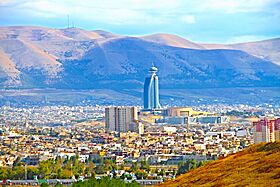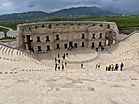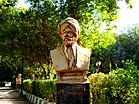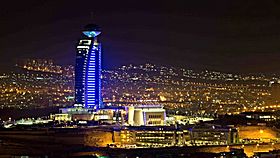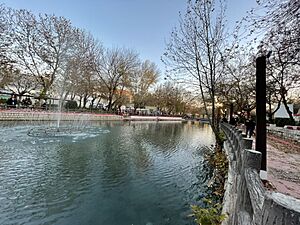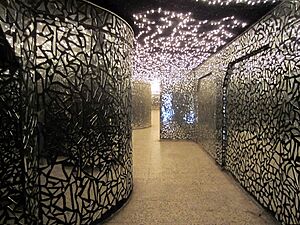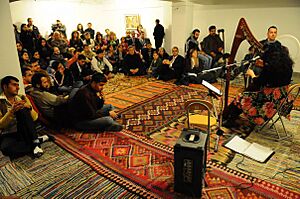Sulaymaniyah facts for kids
Quick facts for kids
Sulaymaniyah
سلێمانی
Silêmanî |
|
|---|---|
|
Top-bottom, R-L:
View over Suleymaniyah Roman amphitheater • Sharafkhan Bidlisi statue Amna Suraka Museum • Sulaymaniyah Museum Suleymaniyah at night |
|
| Country | |
| Region | Kurdistan Region |
| Governorate | Sulaymaniyah Governorate |
| Elevation | 882 m (2,895 ft) |
| Population | |
| • Estimate
(2018)
|
676,492 |
| Time zone | UTC+3 (AST) |
| Website | https://slemani.gov.krd/ |
Sulaymaniyah, also called Slemani, is a large city in the eastern part of the Kurdistan Region in Iraq. It is the capital city of the Sulaymaniyah Governorate. The city is surrounded by mountains like Azmar, Goizha, and Qaiwan in the northeast. Baranan Mountain is to the south, and the Tasluja Hills are in the west. Slemani has a climate with very hot, dry summers and cold, wet winters.
The modern city of Slemani was started in 1784. It was founded by an Ottoman-Kurdish prince named Ibrahim Pasha Baban. He named the city after his father, Sulaiman Pasha. From 1784 to 1850, Slemani was the capital of the historic Baban principality.
Contents
History of Sulaymaniyah

Before Slemani was founded in 1784, this area was known as Zamwa. The capital of the Kurdish Baban principality used to be a place called "Qelaçiwalan". During the time of the Baban rulers, there were many fights between the Safavid dynasty and the Ottoman Empire. Qelaçiwalan often became a battlefield.
In 1783, Ibrahim Baban became the ruler of the area. He decided to build a new capital city. In 1784, he finished building many palaces for trade and markets. These places were also used as baths. He invited people from nearby villages to move to the new city. The new city was named Slemani after Sulaiman Baba. He was the first Baban prince to control the province of Şarezûr.
In the early 1800s, people from Ardalan moved to Slemani. This included Mastoureh Ardalan, a famous writer. She wrote about Kurdish history. She was buried in Slemani when she died in 1848.
From 1922 to 1924, Slemani was the capital of the Kingdom of Kurdistan. This was a short-lived state. It was declared by Iraqi Kurds after the Ottoman Empire fell apart.
Population Growth in Slemani
In 1820, a British visitor named Rech estimated the city's population. He thought there were more than ten thousand people. This included 2,000 Muslim families, 130 Jewish families, and 14 Christian families.
By 1947, the number of people living in Slemani grew to 23,475. At that time, about 1,517 Jewish people lived in the city. Most of the Jewish community moved to Israel in 1951–52.
By 1998, the population was about 548,747. In 2015, it grew to an estimated 656,100 people. In 2016, one university estimated the population to be 800,000.
Geography and Climate
Slemani is located in northern Iraq. Compared to other major cities in Iraq, it has cooler summers. It also has more rain in the winters. Average temperatures range from 0 to 39 degrees Celsius. In winter, there can be a lot of snow. Snow usually falls every year or two.
The climate of Slemani is classified as a hot-summer Mediterranean climate. This means it has hot, dry summers and mild, wet winters.
| Climate data for Sulaymaniyah (1991-2021) | |||||||||||||
|---|---|---|---|---|---|---|---|---|---|---|---|---|---|
| Month | Jan | Feb | Mar | Apr | May | Jun | Jul | Aug | Sep | Oct | Nov | Dec | Year |
| Mean daily maximum °C (°F) | 8.6 (47.5) |
10.7 (51.3) |
15.5 (59.9) |
20.8 (69.4) |
27.3 (81.1) |
34.3 (93.7) |
38.5 (101.3) |
38.7 (101.7) |
33.7 (92.7) |
26.4 (79.5) |
16.5 (61.7) |
11.0 (51.8) |
23.5 (74.3) |
| Daily mean °C (°F) | 3.4 (38.1) |
5.3 (41.5) |
9.8 (49.6) |
14.8 (58.6) |
20.8 (69.4) |
27.3 (81.1) |
31.4 (88.5) |
31.4 (88.5) |
26.5 (79.7) |
19.6 (67.3) |
10.4 (50.7) |
5.4 (41.7) |
17.2 (62.9) |
| Mean daily minimum °C (°F) | −1.5 (29.3) |
−0.5 (31.1) |
3.1 (37.6) |
7.4 (45.3) |
12.4 (54.3) |
17.9 (64.2) |
22.0 (71.6) |
22.0 (71.6) |
17.5 (63.5) |
12.3 (54.1) |
4.4 (39.9) |
0.3 (32.5) |
9.8 (49.6) |
| Average precipitation mm (inches) | 136 (5.4) |
133 (5.2) |
122 (4.8) |
91 (3.6) |
30 (1.2) |
1 (0.0) |
0 (0) |
0 (0) |
1 (0.0) |
40 (1.6) |
81 (3.2) |
112 (4.4) |
747 (29.4) |
| Average rainy days | 10 | 10 | 13 | 8 | 4 | 1 | 1 | 0 | 0 | 4 | 5 | 11 | 67 |
| Average snowy days | 4 | 2 | 1 | 0 | 0 | 0 | 0 | 0 | 0 | 0 | 0 | 0 | 7 |
| Average relative humidity (%) | 70 | 69 | 61 | 56 | 41 | 24 | 20 | 18 | 22 | 33 | 56 | 67 | 45 |
| Average dew point °C (°F) | −1 (30) |
0 (32) |
2 (36) |
4 (39) |
5 (41) |
3 (37) |
4 (39) |
4 (39) |
2 (36) |
2 (36) |
1 (34) |
2 (36) |
2 (36) |
| Mean monthly sunshine hours | 164.3 | 175.2 | 213.9 | 237 | 316.2 | 408 | 418.5 | 396.8 | 351 | 272.8 | 207 | 167.4 | 3,328.1 |
| Mean daily sunshine hours | 5.3 | 6.2 | 6.9 | 7.9 | 10.2 | 13.6 | 13.5 | 12.8 | 11.7 | 8.8 | 6.9 | 5.4 | 9.1 |
| Mean daily daylight hours | 10.5 | 11.4 | 12.4 | 13.6 | 14.5 | 15.0 | 14.8 | 13.9 | 12.8 | 11.7 | 10.7 | 10.3 | 12.6 |
| Source: Climate-Data.org (altitude: 849m), Weatherbase(daylight-dew point-rain and snow days), Weather2visit(sun) | |||||||||||||
Education in Sulaymaniyah
The University of Slemani opened in 1968. It teaches in Kurdish, Arabic, and English. It has different departments like engineering, agriculture, and medicine. This is the biggest university in the Kurdistan Region.
A second university, Sulaimani Polytechnic University, started in 2012. It also teaches in Kurdish, English, and Arabic.
In 2007, The American University of Iraq – Sulaimani (AUI-S) was added. This is a private university. It teaches only in English. It has a special program for learning English as a Second Language.
Culture and Arts
Slemani has two independent newspapers, Hawlati and Awena. There are also two independent political magazines. Since 2016, the city has an International Film Festival. It is organized by the University of Sulaymaniyah.
Slemani is the only city in South Kurdistan that celebrates World Music Day. A journalist from the BBC wrote about Slemani's special culture. They said that culture is very important to Kurdish people, especially in Slemani. The city also has a strong pull towards modern ideas.
Slemani was home to famous poets. These include Nalî, Mahwi, and Piramerd.
Economy and Tourism
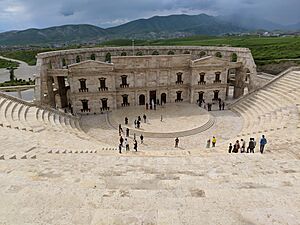
Since 2003, Slemani's economy has grown a lot. Today, its economy depends on tourism and farming. There are also many small factories. Most of these factories are involved in building things.
Visiting Sulaymaniyah
More than 60,000 tourists visited Slemani in 2009. In early 2010, over 15,000 Iranian tourists came to the city. Many were drawn because the city has fewer strict laws than their home country. Many came to celebrate Newroz (the Kurdish New Year).
Museums to Explore
- Sulaimani Museum: This is the second largest museum in Iraq. It has many ancient items. These include Mesopotamian, Kurdish, and Persian artifacts. Some items are from as far back as 1792–1750 BC.
- Amna Suraka museum
- Museum of Modern Art (Mozehanai Hunari Howchah)
- Sulaimani Archeological Museum
Famous People from Sulaymaniyah
- Khâlid-i Baghdâdî (1779–1827), a religious thinker.
- Salim (1800–1866), a poet.
- Nalî (1800–1873), a poet.
- Mahwi (1830–1906), a poet.
- Piramerd (1867–1950), a poet and journalist.
- Muhamed Amin Zaki (1880–1948), a historian and politician.
- Taufiq Wahby (1891–1984), a linguist and poet.
- Abdulla Goran (1904–1962), known as the founder of modern Kurdish poetry.
- Ibrahim Ahmad (1914–2000), a writer and translator.
- Jamal Nebez (1933-2018), a linguist and writer.
- Nawshirwan Mustafa (1944–2017), a politician and historian.
- Barham Salih, the 8th president of Iraq.
- Ahmad Hardi (1922–2006), a poet.
- Sherko Bekas (1940–2013), a modern poet.
- Bachtyar Ali (born 1960), a novelist.
- Jalal Talabani (1933-2017), the 6th president of Iraq.
- Sara Omar (1986-), a novelist.
Important Sites
- Tomb of king Cyaxares of Media, located in Qyzqapan.
Sister Cities
Slemani has connections with other cities around the world:
 Tucson, Arizona, USA
Tucson, Arizona, USA Naples, Italy
Naples, Italy
Getting Around Sulaymaniyah
The city has an airport called Sulaimaniyah International Airport. You can fly there with many airlines. These include Iraqi, Qatar Airways, Royal Jordanian, and Turkish Airlines.
Images for kids
-
Mahmud Barzanji, a historical figure.
See also
 In Spanish: Solimania para niños
In Spanish: Solimania para niños


